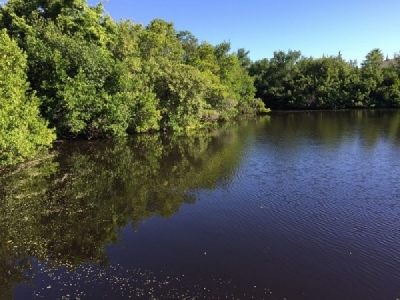
Posted on October 17, 2018
Commissioners aren’t sure about what to do for the future of Spring Lake, and they’re hoping the lake’s residents will step up to help them make a decision.
City Engineer Lynn Burnett presented commissioners with a water quality report and lake assessment for Spring Lake during an Oct. 9 meeting. Burnett said she agreed with the assessment made by Aquatic Systems Lake and Wetland Services to install an aeration system to improve oxygen levels in the polluted lake and monitor the water quality periodically.
Burnett also suggested dredging the lake to remove pollutants on the bottom and adding a connection to a freshwater well to refill the lake as needed. Two things that city commissioners weren’t sure about with the plan are the cost to dredge the lake and whether the currently saltwater lake should be cut off from tidal waters and made into a freshwater lake.
The report listed the lake’s waters as well over the recommended levels for phosphorus, nitrogen and ammonia, with levels significantly higher at the bottom of the lake than at the top. The oxygen level in the lake is listed as critically low and unable to support aquatic life. The lake’s waters also have high levels of chloride, salt, dissolved solids and suspended solids.
Burnett said that pollution in the lake is caused by a number of things including fertilizers and sediment washing in from nearby houses, dumping into the lake and leakage from a nearby waste station, the same one that had a massive leak more than two years ago, dumping around 30,000 gallons of wastewater into the lake.
With the lake being a man-made structure created from a natural freshwater wetland system, Burnett suggested cutting off the saltwater intrusion to the lake, removing pollutants, dredging the bottom, installing an aeration system, and connecting the lake to natural artesian wells to make the lake a freshwater system. She said, if the residents want it, the lake could be stocked with freshwater fish for fishing. The catch for residents is that to keep the lake clean of pollutants, residents surrounding the lake would not be able to fertilize their rear yards because of runoff into the lake system.
“It’s beautiful back there,” she said. “I hope the residents would want to protect and preserve it.”
Commissioners Judy Titsworth and Carol Soustek were both concerned about dredging at the lake. Titsworth said she understands dredging to be expensive and there’s a lack of access to Spring Lake. She also questioned where materials would be dumped after removal from the water. Soustek questioned if it would be possible to remove pollutants over time with aeration and pellets designed to break down the pollutants in the water. Burnett said she’d have to get quotes and speak with experts to be able to come back to commissioners with options for viable solutions.
“We need to find a way to fix it,” Soustek said of the lake.
Lake resident Melissa Williams gave commissioners an impassioned plea during public comment to allow the lake to remain saltwater, as it has been since the 1950s, calling it “a wonderful mistake.”
Titsworth noted the lake would be easier to maintain if it was left as a saltwater lake and questioned if it would be possible to clean the lake then restock it with fish.
Burnett said she would look into the possibility to present commissioners with all of the options. To allow the lake to remain tidal, she said the WaStop valve on the outflow pipe at Grand Canal would have to be removed and the lake’s residents would then be subject to flooding from king tides and sea level rise. While she understands that the lake has been a saltwater lake since it was turned from wetlands without permits in the 1950s, sea level rise makes it a different situation for surrounding residents in the coming decades.
Source: amisun





